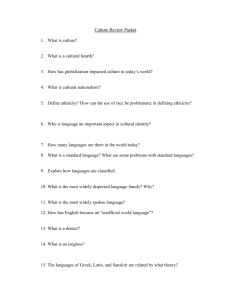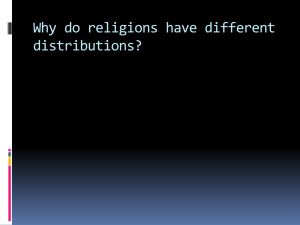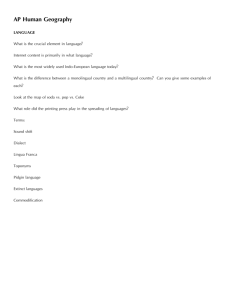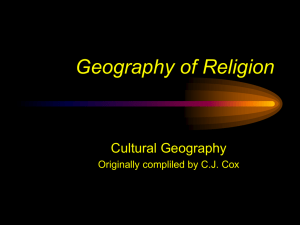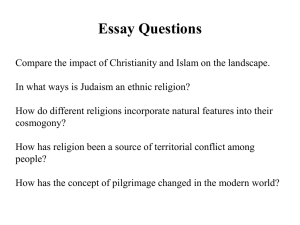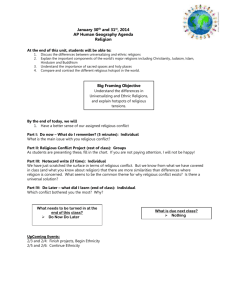Culture - Davis School District
advertisement
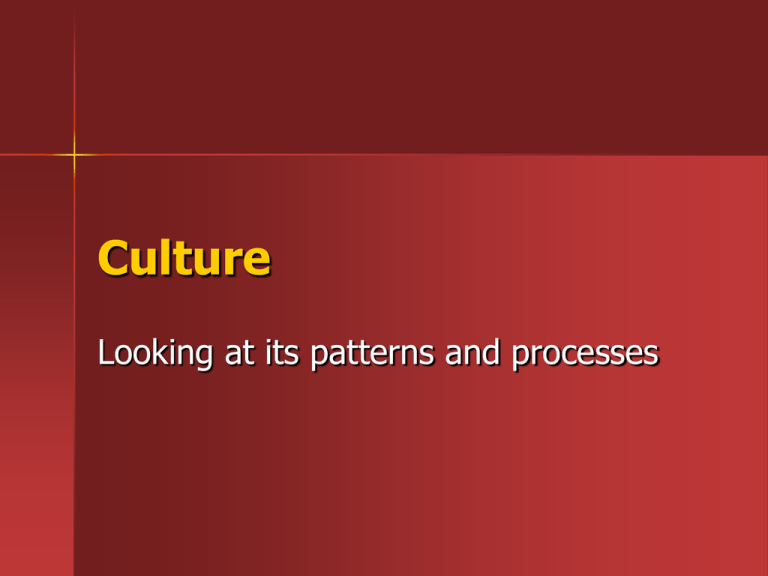
Culture Looking at its patterns and processes Agree with Karl Popper – “The more we learn about the world, and the deeper our learning, the more conscious, specific, and articulate will be our knowledge of what we do not know.” Culture Introduction Culture is everywhere! Cultural Geography: study of people’s lifestyles, their creations and their relationships to the earth and the supernatural Involves both tangible and non-tangible areas of study – Example: architecture and religion Culture is gigantic and difficult to study! Culture Basics Culture defined: a people’s way of life, their behaviors, and their shared understanding of life Culture is a learned system of meaning – Material components of culture: tangible artifacts that can be physically left behind like clothing and architecture – Nonmaterial components of culture: thoughts and ideas of a people like religions or morals Carl Sauer: developed idea of cultural landscape (a.k.a. built environment) – The cultural landscape comprises the physical implications of human culture-where human culture exists, it leaves a cultural landscape as their unique imprint on the earth Cultural Basics, cont. Culture changes all the time and leaves historical remnants all over Sequent occupance defined: the succession of different cultures – Example: La Plaza de las Tres Culturas Cultural ecology defined: the systematic study of human-environment interaction The Layers of Culture Culture trait: simplest component, a single attribute of a culture – Example: food, clothing, shaking of hands Culture complex: combination of all cultural traits to create a unique set of traits – Example: American culture or Japanese culture Culture systems: when culture complexes share particular traits and they merge together – Example: people in the South speak with different accent that people in the North but still share a the larger American culture Nature of Culture Conclusions Anthropologists and Historians have come to about the nature of culture: Learned, shared behavior Necessary for cooperation – establishes predictability and trust Culture is irrational – not internally consistent, nor does it consistently recommend the “right” choices Defines what is “real” – the nature of reality Every society, and therefore individual, is influenced by multiple layers of culture. Environmental Determinism One thought that answers question “Does the earth make humans take the actions they do.” Developed by Greeks and says human behavior is controlled by physical environment “Ideal” climates lead to productive civilizations – Example: ancient Egypt along the Nile or Florida Harsher climates do not create productive cultural groups – Example: Siberia or countries in the Sahara desert Possiblism Provides a counterargument to environmental determinism Argues that natural environment places no restrictions on humans whatsoever! Believes that restrictions humans face are placed on ourselves – Example: Phoenix, Arizona Political ecology takes it one step further and argues the government of a region affects the environment which in turns affects choices available to people in the region Folk and Popular Culture Folk culture: limited to smaller region and smaller number of people than pop culture – Usually isolated groups that have long-lasting culture traits that haven’t substantially changed over time Example: Amish Popular culture: mass culture that diffuses rapidly – Example: 1960’s or Rock and Roll Gender Issues in Culture Defined: category of classifying humans reflecting not just biological but also social differences between men and women Throughout history, there has been a gender gap. Current issues include – High maternal mortality rates-women in less developed countries are 100-600 times more likely to die in childbirth – Female infanticide: seen in countries where men are more desired like China or India where parents can’t pay the dowry – Dowry Death: a bride is killed by her husbands family because her father didn’t/couldn’t pay the dowry – Enfranchisement: most women can’t vote today – Gender imbalance: places like China and India where men outnumber women creating huge social problems – Longevity gap: despite issues, women typically live longer than men Ethnic Issues in Culture Defined: sets of rules that people create to define their group through actual or perceived shared culture traits, such as language, religion and nationality Very debated term because no one really knows how to define global ethnicities Ghetto: region in which an ethnic minority is forced to live by economic, legal or governmental pressures Ethnic Enclave: place in which an ethnic minority is concentrated, sometimes in the form of a ghetto Enclave: a place in which a minority group is concentrated and surrounded by a hostile or unwelcoming majority Barrio: Spanish-speaking enclave in a city Race issues in Culture Defined: classification system of humans based on skin color and other physical characteristics Throughout history, race has been used to separate groups of people – Example: Apartheid, South Africa It is not always a clear distinction between race and ethnicity but ethnicity is usually seen to incorporate more than just race – Example: Turks in Germany Culture Regions and Realms We already learned formal, functional and perceptual regions-there is another type, cultural regions Culture region defined: drawn around places and peoples with similarities in their culture systems – Becomes more a question of perspective than anything else! Culture realm defined: merging together of culture regions People typically feel a sense of emotional attachment to particular regions leading to regional identities Regional identities often lead to perceptual regions – Example: People from Texas consider themselves from the Southwest but people from California consider Texans to be southern Cultural Diffusion Cultural diffusion defined: spread of people’s culture across space – Two categories of diffusion exist Expansion diffusion: cultural component spreads outward to new places while remaining strong in its original hearth Relocation diffusion: actual movement of original adopters from their point of origin (hearth) to a new place Spatial diffusion: spread of any phenomenon across space (like a disease) Expansion Diffusion Several forms exists Stimulus expansion diffusion: happens when an innovative idea diffuses from its hearth outward but original idea is changed by new adopters – Example: Microsoft Contagious expansion diffusion: when numerous places or people near the point of origin become adopters (or infected in the case of disease) – Example: spread of diseases or KFC restaurants Hierarchical expansion diffusion: occurs when diffusion innovation or concept spreads from a place or person of power or high susceptibility to another in a leveled pattern – Example: rap music moved from large to small cities Relocation Diffusion Different from expansion diffusion where innovation or disease does the moving, here the people do the moving – Examples: HIV/AIDS, Chinese food in America Migrant diffusion: where innovation spreads and lasts only a brief time in the newly adopted placemakes finding the place of origin difficult – Example: the flu, native languages Most diffusion is mixed and doesn’t fit into one category! – Example: HIV/AIDS Maladaptive Diffusion Defined: adoption of a diffusing trait that is impractical for a region or culture Occurs because popular culture doesn’t always reflect its original environment Many see this as a negative because pop culture has lead to an increase in consumption – Created overfilled landfills with water bottles or people driving by themselves instead of in carpools Examples – Blue jeans in warm climates – What examples can you think of? Cultural Convergence Defined: process of two cultures adopting each other’s traits and becoming more alike Typically, when two cultures come into contact, one will be more powerful than the other Acculturation: when “weaker” of two cultures adopts traits from more dominant culture – Example: foreign foods in U.S. or immigrants being bilingual Assimilation: when original traits of weaker culture are completely erased and replaced by traits of more dominant culture – Example: war, immigrants no longer speaking native language Transculturation and the S-Curve Transculturation defined: occurs when two cultures of just about equal power or influence meet and exchange ideas or traits without the domination seen in acculturation and assimilation – Example: idea of “melting pot” in U.S. S-curve: path diffusion often follows – – – – Early adopters: innovators Majority adopters: more people adopt innovation Late adopters: stragglers to innovation Example: computers or cell phones Sample S-Curve Technology S-Curves Cultural Imperialism Defined: the invasion of a culture into another with the intent of dominating the invaded culture politically, economically and/or socially Many people in the world feel that globalization is really cultural imperialism Cultural nationalism has risen in response to cultural imperialism-it is the rise of anticultural imperial forces, the fight by regions and cultures to resist cultural convergence and imperialism and remain distinct Cultural homogeneity: cultural sameness – This is being seen across the globe because of globalization and the internet Ethnic Cleansing Used throughout history to justify the systematic destruction of one particular ethnic group Usually happens in area where cultural imperialism is occuring or has historically occurred! Defined: process in which a racial or ethnic group attempts to expel from a territory another racial or ethnic group When ethnic cleansing is taken one step further it becomes genocide (when a racial or ethnic group tries to kill another racial or ethnic group) Examples: – Slobodan Milosevic in the former Yugoslavia – Hitler and the Jews – Darfur region of Sudan Cultural Hearths Defined: areas where innovations in culture began, such as where agriculture, government and urbanization originated Considered the sources of human civilization Independent innovation: where hearths invent innovations without knowing about each other – Example: agriculture developing in Mesopotamia and East Asia at same time Locations of cultural hearths List of accepted cultural hearths Andean American: eastward direction through South America Mesoamerica: eastern and western North America West Africa: throughout Africa Nile River Valley: throughout Africa and SW Asia Mesopotamia: throughout SW Asia, Europe, Central and East Asia, West Africa Indus River Valley: SW, Central and East Asia Ganges River delta: South, SE and SW Asia Wei and Huang rivers (China): East and SE Asia Language Language Combined with religion, language creates the fundamental components in cultural identity Language is culture trait that is learned and passed on from one generation to another Estimates are language emerged nearly 2.5 million years ago Language divergence: when speakers of the same language scatter and develop variations of that original form of the language to meet needs for new surroundings – Example: original language may not have had word for iceberg because they never saw one Language, cont. Language replacement: when invaders replace the language of those they conquer Replacement can lead to language extinction (when a language is no longer used by people in the world) Geographers trace language diffusion paths through reverse reconstruction – If two languages share a common word for an extinct animal that no longer exists – That animal only existed in one of the many places where the two languages are now spoken – Then one possible conclusion is that the language diffused from the place where the extinct animal once existed and speakers carried the word for that animal with them Language Tree Developed by Geographers to organize languages and is divided into the following hierarchy – 19 language families Each family has its own branches – Each branch has its own groups Each group has its own language each language has its own dialects Major Language Families Indo-European: 430 languages spoken by 44.78% of the world Sino-Tibetan: 399 languages spoken by 22.28% of world Niger-Congo: 1,495 languages spoken by 6.26% of world Afro-Asiatic: 353 languages spoken by 5.93% of world Austronesian: 1,246 languages spoken by 5.45% of world Dravidian: 73 languages spoken by 3.87% of worlds Confusion Alert! There is no clear consensus on what exactly is and is not a family. – Some people want to put it as the highest level (the 19 language families) – Others use it to mean smaller groups (Germanic Family) Indo-European Hearth About 50% of all people speak an Indo-European language, most prominent is English Location of this hearth is speculative Conquest theory says it began in empire-building Kurgan culture located in steppe region of Russia, north of the Caspian Sea Agricultural theory says it started in farming community in Danube River region Either way, it is believed to have settled between 6000 and 4500 BCE Monolingual and Multilingual States Language can tie a state together or create disunity Multilingual states: countries where more than one language is spoken – Can cause conflict over language and ties to national identity and power Monolingual states: contain speakers of only one language – Very difficult to find in world of globalization but some countries fighting to keep monolingual status like France Multilingual Conflict Examples Canada: English vs. French – Quebec (French speaking) want recognition and power against English majority – Some have called for secession from Canada Belgium: Dutch vs. French – Dutch speaking North, French speaking south competing for control over government Cyprus: Greek vs. Turkish – Greek majority and Turkish minority compete for control of island – Currently divided by “green-line” partition separating the two cultures Nigeria: Hausa, Yoruba, Ibo and 230 other languages – Hausa in north, Yoruba in SW and Ibo in SE divide Nigeria with 230 other languages adding complications for unity – English is official language in attempt to create common communication Multilingual State: Nigeria Official and Standard Languages Official language: declared by leaders of country to be the language used in legal and governmental proceedings – Usually it is language of majority – Can have more than one official language – Examples: Nigeria and English, Canada and French and English Standard language: acceptable form of a given language as declared by political or societal leaders – Example: Britain teaches British Received Pronunciation English in schools instead of American English Last of Language Stuff Lingua Franca: language used to facilitate trade – Example: In Africa where many native languages are spoken, business uses English or French Pidgin: a simplified version of a language Creole: a language that is mixed from a group of colonizers and the people they colonize Toponyms Defined: place names that reflect cultural identity and impact the cultural landscape These can tell us what cultures value Examples: – Controversy in India over renaming the city of Bombay to Mumbai-English had named it Bombay but Mumbai relates to an Hindu God – St. Petersburg in Russia named by Peter the Great – Paradise, California – Hell, Michigan Cultural Identities and Landscapes Looking closely at what defines culture Religion Religion defined: a set of beliefs and activities that are created to help humans celebrate and understand their place in the world Religions help define right and wrong within a culture Can have profound impact on human interaction with the environment through architecture, ideas about land, etc Religion is the single largest determiner of culture! 2 religious classifications Universalizing vs. Ethnic – Universalizing: try to have universal appeal and attract all people to their beliefs Example: Christianity, Islam – Ethnic: attempt to appeal not to all people but to one group, usually in one place or of one ethnicity Example: Hinduism, Judaism Polytheistic vs. Monotheistic – Polytheistic: belief in many supreme beings Example: Hinduism, maybe Buddhism – Monotheistic: belief in one supreme being Example: Christianity, Islam, Judaism World Religious Regions Ethnic Religions Developed before the major universalizing religions Largest are Hinduism and Judaism East Asian ethnic religions have many branches/sects Hinduism Origins: has more than 900 million adherents, mostly living in India – Evolved in Indo-Gangetic Heart in about 2000 BCE – Oldest religion on earth – Has many sacred texts including the Vedas and the Baghavad Gita Diffusion Route: spread from Indo-Gangetic Hearth eastward via the Ganges and south through India – Blended with other faiths – Never really left India and is closely tied to Indian culture Primary Branches: no real formal branches exist – Can be considered both monotheistic and polytheistic Basic Beliefs Reincarnation: continue through cycle until reaching enlightenment Karma: universal law of justice Trinity: Brahma, Vishnu and Shiva – – – – Brahma: creator of the world Vishnu: he loves you Shiva: god of duality, both destroyer and fertility Ganesh(a): remover of obstacles-NOT part of the Trinity – – – – – Brahmans: educated elite, priests Kshatryas: military class Vaisyas: merchants and farmers Sudras: peasants Untouchables: truly “untouchable” Caste system: social hierarchy based on Karma Cultural Landscape Features Ganges river holy to bathe in Temples frequently have food as offerings to Gods Cremation of dead most common Hindu Gods Judaism Origins: oldest monotheistic religion on earth created 2000 BCE in Semitic Hearth – Grew out of tribal belief of Jews whose headquarters became Jerusalem – Abraham is considered founder and root of religions – Sacred text is Torah (Biblical Stories) and Talmud (rabbinical and historical teachings) Diffusion route: After Rome destroyed Jerusalem, Jews were scatter throughout world in Diaspora (a scattering of any ethnic group) – Jews scattered into central Europe and toward Iberian Peninsula – Currently about 18 million Jews world wide with many living in Israel – 66% of Jews live in the U.S. and Israel (created in 1948 as homeland for Jews) Basic Beliefs There is one God, Jehovah There will be a Messiah or Savior 10 commandments Kosher: dietary law based in Old Testament Primary Branches – Orthodox: seeks to retain the original traditions of the faith – Reform: developed in 1800s attempting to adjust the religion to fit more modern times – Conservative: most recent branch, more moderate approach to the religion than either Reform or Orthodox Cultural Landscape Features Synagogue: house of worship and community gathering – All have an ark housing the Torah Western Wall in Jerusalem, believed to be western side of Temple Mount complex that was destroyed Six-pointed star East Asia Religions Shintoism: syncretic, ethnic religion blending Buddhism with Japanese local religions – About 118 million adherents – Ancestor worship and Buddhism Taoism (Daoism): Chinese idea based on philosopher Lao Tzu who lived about 6th century BCE – Teaches people should live in harmony with nature in all aspects of their lives – Created feng shui the practice of organizing living spaces in harmonious ways Confucianism: Chinese philosopher who lived around the same time as Laozi – Teachers a system of morals and way of life for Chinese in areas like government, education, religion and philosphy – Focuses more on worldly life rather than idea of heaven and hell – Both spread to Korean Peninsula, Japan, SE Asia, North American and Europe – Together estimated 263 million followers Shamanism and Animism Shamanism: term given to any ethnic religion in which community follows its Shaman, or religious leader, healer and truth knower Historically found in North America, SE Asia and East Asia Animism: belief that objects such as trees, mountains and rivers have spirits in them Taught by some Shamans Universalizing Religions Followed by about 60% of worlds population Can be broken down into branches, denominations and sects – Branches: large fundamental divisions with in a religion Example: Catholicism and Protestantism – Denominations: groups of common congregations within a branch Example: Anglicans and Episcopalians – Sects: smaller groups that have broken away from recognized denomination within a branch Example: Fundamentalist Church of Jesus Christ of Latterday Saints Examples include: Buddhism, Christianity, Islam and Sikhism Buddhism Origins: worlds first universalizing religion – Developed out of Hinduism and caste system – Founded in India near Indo-Gangetic Hearth between Indus and Ganges rivers by Prince Siddhartha Gautama born in 644 BCE Diffusion Routes: started in India, spread to China, Korea, Japan, Tibet, Mongolia and Southeast Asia along Silk Road – Now nearly extinct in India – Nearly 350 million followers world wide Basic Beliefs of Buddhism 4 noble truths – Life is suffering and inherently painful – Suffering has a cause: craving and attachment (selfishness) – Craving and attachment can be overcome – By following the eightfold path Eightfold path – Right Concentration, Right Purpose, Right Speech, Right Conduct, Right Livelihood, Right Effort, Right Alertness, Right Understanding Reincarnation: humans cycle through until reaching enlightenment Karma: Universal law of justice Branches of Buddhism Theravada: monastic, practiced by nearly 55% of all Buddhists – Found mainly in SE Asian countries like Sri Lanka, Myanmar, Thailand, Laos and Cambodia Mahayana: do not spend time as monks but find salvation (enlightenment) through meditation and prayer – Practiced by 40% of Buddhists and found primarily in Korea, Vietnam, Japan and China Lamaism in Tibet: combines monasticism of Theravada with local images of deities and demons-practiced only by about 5% of Buddhists – Leader is Dalai Lama who has been exiled from Tibet by Chinese government Zen: exists primarily in Japan but growing in popularity in U.S. – Believes in original mind Cultural Landscape Features Most famous structure is pagoda which is made to look like ancient burial mound shapes Bodhi tree in India where Buddha reached enlightenment while meditating under it Christianity Origins: second universalizing religion to develop as offshoot of Judaism when Jesus Christ was seen as expected Messiah by disciples Hearth: near modern day Israel Diffusion Route: used both expansion and relocation diffusion from Palestine, has nearly 2 billion adherents – 312 CE Roman Empire adopted Christianity as official religion – 15th Century colonization efforts of Europeans spread it as well – Today nearly 90% of Western Hemisphere is Christian Basic Beliefs Jesus Christ is the Son of God Bible is sacred text Belief of love, forgiveness and repentance Some branches/sects accept prophets, some do not All believe in personal God who is unchanging Branches of Christianity Roman Catholics: largest and original piece of Christianity with nearly 830 million adherents – Hierarchical religion because of well defined organization with Pope at top – No real divisions – Headquartered in Vatican City in Rome, Italy Protestant Christians: nearly 503 million adherents, broken into denominations – Baptist, Methodist, Pentecostal and Lutheran are largest denominations – Began in 15th Century with Protestant Reformation Eastern Orthodoxy: developed in 1054 when Roman Catholic Church split – Collection of 14 self-governing churches, largest being Russian Orthodox – Has nearly 192 million adherents and is rooted in Constantinople Cultural Landscape Features Varied landscape reflects varied history Catholicism has Cathedrals in almost every city Protestantism is usually simple, wood, plain churches Islam Origins: was 3rd Universalizing religion to develop, originated in Mecca, Saudi Arabia around 600 CE – Last prophet was Muhammad, has nearly 1.2 billion adherents – Is 2nd largest but fastest growing religion on earth – It is monotheistic and sacred text is the Koran Diffusion Route: diffused through Mohammed’s followers who organized armies through Africa, Europe and Asia – Successful diffusion led to Crusades by Europeans to “take back” and “save” lands that had been conquered by Muslims Basic Beliefs 5 pillars of Islam Faith: accepting Allah as the only God, Mohammad as his final prophet and the Qur'an as Allah’s words Prayer: pray 5 times a day, facing Mecca Fasting: during month of Ramadan in memory of Mohammad’s first vision Almsgiving: a.k.a. Zukat, giving of money to care for the less fortunate; about 2 ½% of one’s income and can be public or private Hajj: a.k.a. pilgrimage-once in a lifetime trip to Mecca Primary Branches Sunni: means orthodox – About 85% of Muslims practice this – Dominate in Arab-speaking areas of Bangladesh and Pakistan – Believe Sunni Caliphs (religious emperors) in the Umayyad Dynasty were not descendants of Muhammad, nor were Ottoman emperors Shi’ite: majority in Iran and Iraq – Account for nearly 15% of adherents – Shia believe descendants of Ali were acceptable authorities in Islam Sufi: less than 3% of Muslims – Mystical sect – Example: Twirling Durbishes Cultural Landscape Features Mosque: center of Muslim worship, typically has four minarets or towers used to called worshippers No depiction of human or animal form Mecca Largest World Religious Bodies Catholic Church Sunni Islam Eastern Orthodox Anglican Assemblies of God Seventh-day Adventists Jehovah’s Witnesses LDS Church New Apostolic Church Ahmadiyya Bahai 1,100,000,000 875,000,000 225,000,000 77,000,000 50,000,000 16,811,519 16,500,000 12,275,822 10,260,000 10,000,000 6,000,000 Secularism and Theocracy 4 billion people world wide believe in some religion or faith Millions of people have accepted secularism instead of religion Secularism: movement away from control of life by religion Other countries have accepted a theocracy Theocracy: government run by religion Religion and Conflict Throughout history, humans have fought over territory thought to be sacred Interfaith boundaries: divide space between two or more religions Intrafaith boundaries: divide space within one religion, often among denominations Boundaries can lead to conflict that is often very passionate and violent Examples of Interfaith Boundaries China and Tibet: between Tibetan Buddhism and Atheism Nigeria: between Islam and Christianity India: between Hinduism and Sikhism in NW state of Punjab, Sikhist government wants autonomy from Hindu Indian government India and Pakistan: between Islam and Hinduism Former Yugoslavia: between Christianity and Islam Israel: between Judaism and Islam Examples of Intrafaith Boundaries Iraq: Sunni and Shia Islam United States: Christian fundamentalism and moderate, liberal Christianity Northern Ireland: Protestant Christians and Roman Catholics

